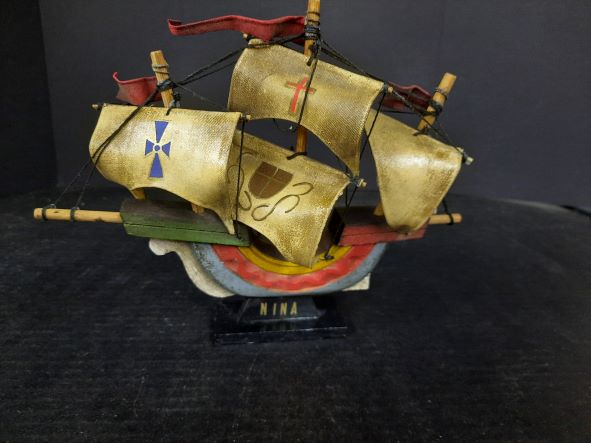
Model of the ship Nina
Model of the ship Nina – hand made and hand painted. No number or museum card. On Columbus’s first expedition, Nina carried 26 men, captained by Vicente Yvez Pinzon. They left Palos de la Frontera on 3 August 1492, stopping at the Canary Islands on 12 August 1492, and continued westward. Landfall was made in the Bahamas at dawn on 12 October 1492. On 14 February 1493, in the east of the Azores, a storm threatened to capsize Nina, and at Columbus’s instigation, he and the crew took a series of vows to perform certain acts including religious pilgrimages upon their return to Spain. Nina reached Lisbon, Portugal, on 4 March 1493, and arrived in Palos de la Frontera on 15 March 1493. On the first voyage to America, the crew of Nina slept on the deck but adopted the use of hammocks after seeing Native Americans utilizing them. In September 1493, Nina joined a grand fleet of 17 ships for the second voyage to Hispaniola, becoming the flagship for an exploration of Cuba. She was the only ship to survive the 1495 hurricane, returning quickly to Spain in 1496.
Nina was then chartered for an unauthorized voyage to Rome. She was captured by a pirate corsair when leaving the port of Cagliari and brought to Cape Pula, Sardinia. The Captain, Alonso Medel, escaped with a few men. He stole a boat, rowed back to Nina, and made sail, returning to Cadiz.
In 1498, she returned to Hispaniola as advance guard of Columbus’s Third Voyage. She was lying in wait at Santo Domingo in 1500. In 1501, she made a trading voyage to the Pearl Coast on the island of Cuba, Venezuela, and no further log of her is found in historic archives.[7]
Nina logged at least 25,000 nautical miles (46,000 km) under Columbus’ command.